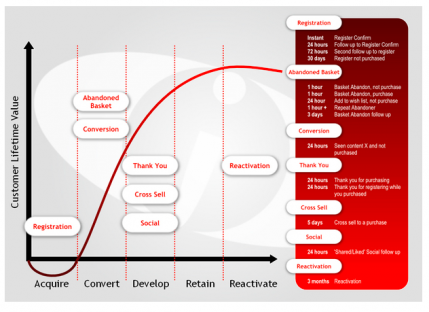 Striking down opponents with your ninja online marketing skills can provide a sense of satisfaction that many marketers crave. However, there is danger in focusing all of your efforts on the front end of the customer buying cycle.
Striking down opponents with your ninja online marketing skills can provide a sense of satisfaction that many marketers crave. However, there is danger in focusing all of your efforts on the front end of the customer buying cycle.
Do you know how much it costs to acquire new customers versus retaining those that have already signed with you? According to a recent study it costs roughly six to seven times more to gain a new customer, than to keep an existing one. Email marketing is one of the many ways that we can communicate with customers on an ongoing basis. If you’re tired of the same old ninja stars and nunchuks, I’ve uncovered 5 email marketing tips to add to your arsenal.
A True Ninja Understands Engagement-RFM
According to Econsultancy, Engagement-RFM is a combination of behavioral data, and RFM (Recency, Frequency, Monetary value). Understanding how to craft the appropriate email touch points is key in communicating with your customers on an ongoing basis. The chart below details some of the different cycles within the customer lifetime that can provide guidance in creating email communication.

Well-Trained Ninjas Start the Relationship Off Right
Welcoming new customers into the fold is a fantastic way to set an expectation early on that you will be communicating with them on an ongoing basis. For example, anytime you take on a new customer it would be wise to send them a welcome email. This email could include:
- Key contacts within the organization
- Showing appreciation for the fact that they selected your services over the competition
- Links to helpful resources
- A heads up that your team will be sending emails on an ongoing basis and ask if they would like to sign up.
Different Targets Require Alternate Weapons
You may work with customers in a vast variety of industries, or a smaller group of defined markets. Either way it is essential that you know what makes different customers tick. Say you have a segment of customers within the healthcare industry. It would make sense to flavor your email content in a way that speaks to their unique set of pain points or needs. Alternately, retail customers should receive a different communication.
If you’re sending a monthly newsletter with interesting stories and news, it’s okay to send it to all of your customers. However, it is very important that you also send some email communication that takes into consideration what different customers may have an interest in learning more about. Also, it shows that you’ve taken the time and have an interest in providing assistance in a customized way.
Knowing the Perfect Time To Strike
If ninjas chose the middle of the day in an exposed area to strike, they would not be very successful. Similarly, knowing when and how to bring up particular opportunities with your customers is key. If you’re trying to upsell a customer with additional products or services, you should be aware of what else they may have going on that could affect purchasing decisions.
Sending a direct email communication will always be more effective, but that doesn’t mean that you can’t send an email to all of your customers sharing case studies on success you’ve had with particular programs, or new services or products that you’re rolling out that they might find of interest.
Important Contacts Shall Be Made Aware of the Mission
Most people like to feel that they knew something before the rest of the world. Utilizing email communication to share exciting news or even ask for insight from your customers can accomplish a few things:
- You’ve included your customers as part of the process
- It’s clear that you care about their input
- As a loyal customer, you’ve given them premier access to information noone else has.
Whether you’re an email marketing ninja in training, or training ninjas of your own, connecting with your current customers is key in keeping them happy. A consistent flow of email communication as part of a larger integrated online marketing strategy will strengthen loyalty, retain business, and can even lead to your customers advocating on behalf of your brand.
What type of email communication have you found works best with your customers and what feedback have they shared with you?
Image provided via Shutterstock.


